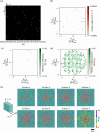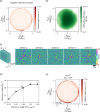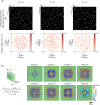Programming of refractive functions
- PMID: 40715120
- PMCID: PMC12297264
- DOI: 10.1038/s41467-025-62230-x
Programming of refractive functions
Abstract
Snell's law dictates the phenomenon of light refraction at the interface between two media. Here, we demonstrate arbitrary programming of light refraction through an engineered material where the direction of the output wave can be set independently for different directions of the input wave, covering arbitrarily selected permutations of light refraction between the input and output apertures. Formed by a set of cascaded transmissive layers with optimized phase profiles, this refractive function generator (RFG) spans only a few tens of wavelengths in the axial direction. In addition to monochrome RFG designs, we also report wavelength-multiplexed refractive functions, where a distinct refractive function is implemented at each wavelength through the same engineered material volume, i.e., the permutation of light refraction is switched from one desired function to another function by changing the illumination wavelength. As experimental proofs of concept, we demonstrate permutation and negative refractive functions at the terahertz part of the spectrum using 3D-printed materials. Arbitrary programming of refractive functions enables new design capabilities for optical materials, devices and systems.
© 2025. The Author(s).
Conflict of interest statement
Competing interests: The authors declare no competing interests.
Figures










References
-
- Born, M. & Wolf, E. Principles of Optics: Electromagnetic Theory of Propagation, Interference and Diffraction of Light (Elsevier, 2013).
-
- Hecht, E. Optics (Pearson Education, Incorporated, 2017).
-
- Engheta, N. & Ziolkowski, R. W. Metamaterials: Physics and Engineering Explorations (John Wiley & Sons, 2006).
-
- Wegener, M. & Linden, S. Shaping optical space with metamaterials. Phys. Today63, 32–36 (2010).
-
- Poddubny, A., Iorsh, I., Belov, P. & Kivshar, Y. Hyperbolic metamaterials. Nat. Photonics7, 948–957 (2013).
LinkOut - more resources
Full Text Sources
Research Materials

